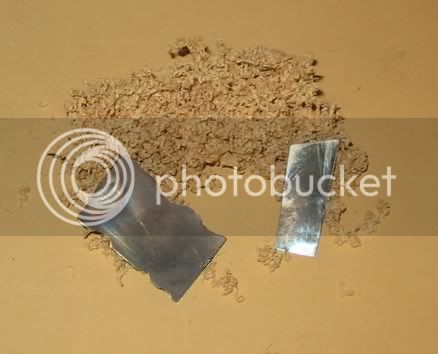Almost any soft steel or medium hard steel can be used to make a scraper.
The shape of the scraper can also be made to produce curves, undercuts or whatever you want to produce.
The key to a good scraper is to have the proper cutting edge on it.
A scraper actually is not just a piece of steel (or glass) with the end ground flat. Yes, this would scrape, but it would do a better job of burnishing than actually cutting material.
As Bob mentioned, the scraper needs to have a cutting edge.
This edge is a little rolled over "burr" where the end of the tool meets the side of it. This burr is, in effect, a feature that cuts the wood and produces little rolled up chips in the process.
Below are a few scrapers I made and examples of the types of chips they will produce:
To sharpen one of these, I clamp it in a vise with the cutting edge sticking up.
I then use a piece of hardened steel (the shank of a twist drill right below the end of the flutes works nicely) and hold it crossways to the scraper against the cutting surface.
Tilting it at a slight angle and working it back and forth along the scrapers cutting surface, rolls a little burr of sharp steel over the edge. I do this to both sides so I don't have to worry about where the burr is.
This burr, by the way, is too small to easily see but you can feel it with your finger.
Do I use this for all of the wood removal? No Way!
IMO, Good (red) Garnet sandpaper is much more efficient at removing wood.
Where the scraper comes into it's own is when working on precision wood removal. Where sand paper would just round off the whole area, the scraper can be used to remove the wood, exactly where you want the wood removed.
It also works nicely to round off corners or produce fillets.
I, personally do not like to use a scraper to cut across the wood grain. It is too easy to produce deep scratches.
They also don't work very easily on Curley Maple because they have a difficult time of cutting the end grain in the woods curl (the dark stripes). I'm not saying don't use them on Curly Maple, but if you do, watch the wood closely to see if the surface is becoming rough and wavy.
Have fun!






